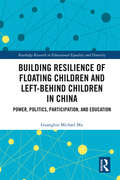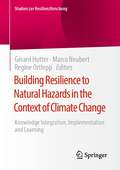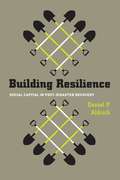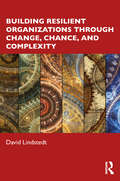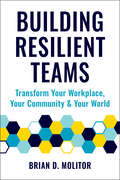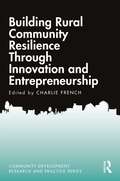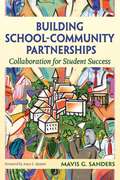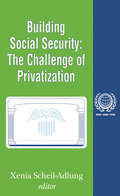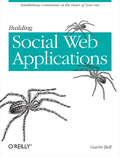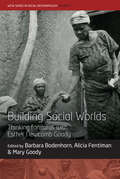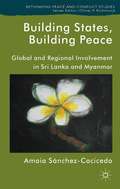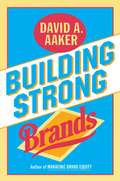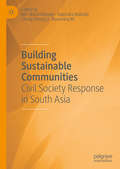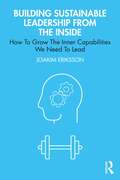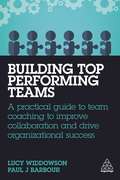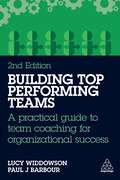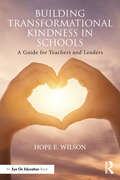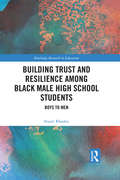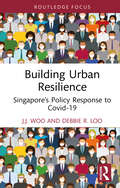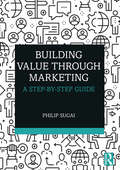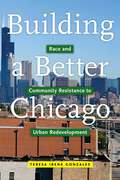- Table View
- List View
Building Resilience of Floating Children and Left-Behind Children in China: Power, Politics, Participation, and Education (Routledge Research in Educational Equality and Diversity)
by Guanglun Michael MuThe past two decades have seen exponential growth of urbanisation and migration in China. Emerging from this growth is a population of floating and left-behind children which is estimated to be approaching 100 million. Due to their increasing risks of undesirable educational and social, as well as health and psychological, outcomes, there is a great urgency to help floating children and left-behind children beat the odds. This book offers an analysis of how oscillations of government discourse have come to shape central and local educational policies regarding the schooling of these children. It also delves into child and youth resilience in this unique migration context, examining what can be done to build up resilience of floating and left-behind children. In this vein, the book will complement current knowledge and advance context- and culture-specific understandings of child and youth resilience through both school-based and community-based approaches. The book aims to answer a fundamental question: How to help floating children and left-behind children become responsive and resilient to structural deficiencies and dynamics in the migration context of China? This is important reading for scholars, school professionals, community workers, and policy makers to better address the social and educational resilience and wellbeing of floating and left-behind children.
Building Resilience to Natural Hazards in the Context of Climate Change: Knowledge Integration, Implementation and Learning (Studien zur Resilienzforschung)
by Marco Neubert Gérard Hutter Regine OrtleppUrban resilience and building resilience are “hot topics” of research and practice on sustainability in the context of climate change. The edited volume advances the “state of art” of urban resilience research through focusing on three important processes of building resilience: knowledge integration, implementation, and learning. In the volume, knowledge integration primarily refers to the combination of specialized knowledge domains (e.g., flood risk management and urban planning). Implementation refers to realized specific changes of the building stock and related green, blue and grey infrastructures at local level (e.g., for dealing with rising temperatures and heat waves at the neighborhood scale in cities). Learning requires moving beyond single projects and experiments of resilience to enhance sustainability at city and regional scale. The editors adopt an interdisciplinary approach to this volume of the Springer series on resilience. The volume includes contributions from civil engineering, physical geography, the social sciences, and urban planning.
Building Resilience: Social Capital in Post-Disaster Recovery
by Daniel P. AldrichEach year, natural disasters threaten the strength and stability of communities worldwide. Yet responses to the challenges of recovery vary greatly and in ways that aren't explained by the magnitude of the catastrophe or the amount of aid provided by national governments or the international community. The difference between resilience and disrepair, as Daniel P. Aldrich shows, lies in the depth of communities' social capital. Building Resilience highlights the critical role of social capital in the ability of a community to withstand disaster and rebuild both the infrastructure and the ties that are at the foundation of any community. Aldrich examines the post-disaster responses of four distinct communities--Tokyo following the 1923 earthquake, Kobe after the 1995 earthquake, Tamil Nadu after the 2004 Indian Ocean Tsunami, and New Orleans post-Katrina--and finds that those with robust social networks were better able to coordinate recovery. In addition to quickly disseminating information and financial and physical assistance, communities with an abundance of social capital were able to minimize the migration of people and valuable resources out of the area. With governments increasingly overstretched and natural disasters likely to increase in frequency and intensity, a thorough understanding of what contributes to efficient reconstruction is more important than ever. Building Resilience underscores a critical component of an effective response.
Building Resilient Organizations through Change, Chance, and Complexity
by David LindstedtA must-read in the wake of COVID-19, this book unpacks the nature of resilient organizations and how they prepare for unpredictable, complex, and profound change. Organizations that do not adapt and evolve die. To date, however, it has not been at all clear how to build a resilient organization. That puts us all in the unenviable position of trying to ready our organizations for an increasingly uncertain future without the proper guidance to do it. This book introduces 14 elements of resilience that consistently emerge in organizations that have thrived amid adversity and volatility. Resilience is not about determination, grit, cybersecurity, or teams of resilient individuals; resilience, it turns out, is often confused with robustness. Readers will discover how resilient organizations build and employ a distinctive combination of crews, capital, culture, and leadership—and, crucially—how to adapt these combinations for their own organization. Senior business leaders, consultants, entrepreneurs, students, and professionals will appreciate this book’s practical, approachable, and engaging guidance, including insights by leaders from Health Care for the Homeless, The Ohio State University, NBCUniversal, retail stores, and more.
Building Resilient Teams: How to Transform Your Workplace, Your Community and Your World
by Brian MolitorAn essential how-to guide to building more efficient and successful organizations at work, in our communities, and in the world as we discover how our humanity transcends all.In an age of self-care and mindfulness, Building Resilient Teams translates those concepts and turns it into the group. All of us are parts of communities, neighborhoods, and other organized systems. These organizations and teams can be further characterized as places where we work, play or worship. The impact of a negative or under productive workplace on individual lives is huge. The good news is that organizations, much like people, can learn, grow and transform once there is a clear path ahead with logical mile markers along the way. Building Resilient Teams provides step-by-step instructions on how to take any organization from where it is now to a level of higher success.
Building Respected Companies
by Jordi CanalsThe current financial crisis has deep macroeconomic roots, but the dominant view of the firm has made the crisis deeper and more devastating. Over the past few decades, maximizing shareholder value has become the main objective of the firm. Chief executives have been keen on this objective because their economic incentives have been clearly associated with stock market performance. Unfortunately, this has driven many CEOs to make terrible decisions based on short-termism and greed. In this way, the firm has become the object of anger, criticism and cynicism. In Building Respected Companies, Jordi Canals argues that we must address this problem by developing companies that serve society, not just their shareholders. This requires a new perspective of what a firm is, what the purpose of the firm in society should be and what the role of the board of directors and senior executives should be.
Building Rural Community Resilience Through Innovation and Entrepreneurship (Community Development Research and Practice Series)
by Charlie FrenchDrawing from empirical analyses, case studies, and a synthesis of best practices, this book explores how innovation manifests itself in rural places and how it contributes to entrepreneurial development and resilience. Innovation in rural places may come about as a result of new forms of collaboration; policies that leverage rural assets and address critical service or product gaps; novel strategies for accessing financial capital; infusion of arts into aspects of community life; and cultivation of networks that bridge entrepreneurs, organizations, and institutions. The chapters illustrate how a number of innovation-related characteristics relate to economic vibrancy in rural places such as a strong connection to the arts, adaptive and sustainable use of natural resources, value-chain integrated food systems, robust bridging social capital networks, creative leveraging of technology, and presence of innovation-focused entrepreneurs. Through exploration of these and other topics, this book will provide insights and best practices for rural community and economic development scholars and practitioners seeking to strengthen the rural innovation ecosystem.
Building Rural Community Resilience Through Innovation and Entrepreneurship (ISSN)
by Charlie FrenchDrawing from empirical analyses, case studies, and a synthesis of best practices, this book explores how innovation manifests itself in rural places and how it contributes to entrepreneurial development and resilience. Innovation in rural places may come about as a result of new forms of collaboration; policies that leverage rural assets and address critical service or product gaps; novel strategies for accessing financial capital; infusion of arts into aspects of community life; and cultivation of networks that bridge entrepreneurs, organizations, and institutions. The chapters illustrate how a number of innovation-related characteristics relate to economic vibrancy in rural places such as a strong connection to the arts, adaptive and sustainable use of natural resources, value-chain integrated food systems, robust bridging social capital networks, creative leveraging of technology, and presence of innovation-focused entrepreneurs. Through exploration of these and other topics, this book will provide insights and best practices for rural community and economic development scholars and practitioners seeking to strengthen the rural innovation ecosystem.
Building School-Community Partnerships: Collaboration for Student Success
by Mavis SandersThis current era of high stakes testing, accountability, and shrinking educational budgets demands that schools seek bold and innovative ways to build strong learning environments for all students. Community involvement is a powerful tool in generating resources that are essential for educational excellence. Building School-Community Partnerships: Collaboration for Student Success emphasizes the importance of community involvement for effective school functioning, student support and well-being, and community health and development. This sharp, insightful book serves as an excellent resource for educators seeking to establish school-community partnerships to achieve goals for their schools and the students, families, and communities they serve. Schools can collaborate with a wide variety of community partners to obtain the resources they need to achieve important goals for students’ learning. Some of these partners may include: - Businesses and corporations - Universities and other institutions of higher learning - National and local volunteer organizations - Social service agencies and health partners - Faith-based organizations and institutions Work successfully with community partners to improve school programs and curricula, strengthen families, and expand your students’ learning experiences!
Building Social Security: Volume 6, The Challenge of Privatization (International Social Security Ser. #Vol. 6)
by Xenia Scheil-AdlungIn recent years, in both the specialist press and the tabloids, the idea of privatization of social security has become a shimmering catch phrase. Politicians base election campaigns on promises of more or less privatization in social security. Many governments introduce private business management methods into their social security systems. Representatives of social security institutions and academics prepare theory papers on the possible outcomes of privatization. And international financial organizations describe doomsday scenarios based on the premise of failure to privatize.What is the role of privatization today in the development of national social security systems? How does privatization concern the developments in different social security programs such as old age, sickness, unemployment, accident insurance and family allowances? What are the visions and effects of privatization in social security?This volume provides an overview of the various positions of supporters and opponents of privatization in the main branches of social security, followed by national experience of privatized or part-privatized social security systems. While the perspective of each of the contributors is markedly different, the overall objective cuts across differences: namely, to develop the most efficient and cost-effective system of social security protection.The authors' views and knowledge are derived from their firsthand experiences with social security in Africa, Asia, the Americas and Europe. Representatives of the leading international organizations dealing with social security issues-the International Labour Organization, the OECD, the World Bank and the World Health Organization-further expand the parameters of the viewpoints and experiences expressed.This multifaceted book allows the reader to learn about the challenge of privatization in the various forms of social security by assembling a set of highly up-to-date, technically complex and legal issues based on practical analysis and actual experience. It will be of interest to those concerned with national social policy in a comparative context. This is the sixth volume in an ongoing series that aims to review social security in a comparative, global context. Xenia Scheil-Adlung is program manager, International Social Security Association, Geneva, Switzerland.
Building Social Web Applications: Establishing Community at the Heart of Your Site
by Gavin BellBuilding a web application that attracts and retains regular visitors is tricky enough, but creating a social application that encourages visitors to interact with one another requires careful planning. This book provides practical solutions to the tough questions you'll face when building an effective community site -- one that makes visitors feel like they've found a new home on the Web.If your company is ready to take part in the social web, this book will help you get started. Whether you're creating a new site from scratch or reworking an existing site, Building Social Web Applications helps you choose the tools appropriate for your audience so you can build an infrastructure that will promote interaction and help the community coalesce. You'll also learn about business models for various social web applications, with examples of member-driven, customer-service-driven, and contributor-driven sites. Determine who will be drawn to your site, why they'll stay, and who they'll interact withCreate visual design that clearly communicates how your site worksBuild the software you need versus plugging in one-size-fits-all, off-the-shelf appsManage the identities of your visitors and determine how to support their interactionMonitor demand from the community to guide your choice of new functionsPlan the launch of your site and get the message out
Building Social Worlds: Thinking forwards with Esther Newcomb Goody (WYSE Series in Social Anthropology)
by Mary Goody Barbara Bodenhorn, Alicia FentimanEsther Newcomb Goody had an extensive academic career. She particularly revisited intellectual themes of kinship and relationships. This collection draws on ethnography across Africa, Europe, Oceania and the Americas, and uses Goody’s ideas to expand their understanding of the nature of relationships, communication, intimacy, resistance and resilience with a particular focus on rich ethnographies of childhood and learning. It discusses a wide range of subjects in personhood and parenthood, fosterage, apprenticeship and modes of learning; kinship in historical perspective; power, politics and speech; the effects of late-modern capitalism on households and the complex relations between persons and things.
Building States, Building Peace: Global and Regional Involvement in Sri Lanka and Myanmar (Rethinking Peace and Conflict Studies)
by Amaia Sánchez-CacicedoThe recent evolution of events in Sri Lanka, the primary case study of this book, has been very different to that in Myanmar, the secondary case study. However, civil conflict endures in both countries. Sri Lanka is now in a state of alleged peace, as there is currently no longer armed violence; however, the roots of the ethno-political conflict remain unchanged.
Building Strong Brands
by David A. AakerAs industries turn increasingly hostile, it is clear that strong brand-building skills are needed to survive and prosper. In David Aaker's pathbreaking book, Managing Brand Equity, managers discovered the value of a brand as a strategic asset and a company's primary source of competitive advantage. Now, in this compelling new work, Aaker uses real brand-building cases from Saturn, General Electric, Kodak, Healthy Choice, McDonald's, and others to demonstrate how strong brands have been created and managed.A common pitfall of brand strategists is to focus on brand attributes. Aaker shows how to break out of the box by considering emotional and self-expressive benefits and by introducing the brand-as-person, brand-as-organization, and brand-as-symbol perspectives. The twin concepts of brand identity (the brand image that brand strategists aspire to create or maintain) and brand position (that part of the brand identity that is to be actively communicated) play a key role in managing the "out-of-the-box" brand.A second pitfall is to ignore the fact that individual brands are part of a larger system consisting of many intertwined and overlapping brands and subbrands. Aaker shows how to manage the "brand system" to achieve clarity and synergy, to adapt to a changing environment, and to leverage brand assets into new markets and products.Aaker also addresses practical management issues, introducing a set of brand equity measures, termed the brand equity ten, to help those who measure and track brand equity across products and markets. He presents and analyzes brand-nurturing organizational forms that are responsive to the challenges of coordinated brands across markets, products, roles, and contexts. Potentially destructive organizational pressures to change a brand's identity and position are also discussed.As executives in a wide range of industries seek to prevent their products and services from becoming commodities, they are recommitting themselves to brands as a foundation of business strategy. This new work will be essential reading for the battle-ready.
Building Sustainable Communities: Civil Society Response in South Asia
by Rajendra Baikady Md. Nurul Momen Cheng Sheng Li M. BasavarajThe book aims to explore South Asian third sector – the nonprofit organizations as provider of social services. The book defines social welfare and describe its relationship to social service programmes and individual well-being; understands the social policy development from the problem identification to policy implementation; describes the range of organization of social service agencies that are responsible for providing social welfare programmes; explores the various roles that professional and non- professional helpers provide in the delivery of social welfare and their influence in promoting change in policy development; and understands the umbrella concept of Child welfare, welfare of people with disability and elderly welfare in welfare policy.
Building Sustainable Leadership from the Inside: How To Grow The Inner Capabilities We Need To Lead
by Joakim ErikssonDrawing on contemporary neuroscience, this book shows leaders how they can literally train their mind to become more resilient and have a more sustainable impact.This is a research‑backed and practical guide for how to grow inner capabilities enabling sustainable leadership in this time. It is built around five areas that many leaders will recognize as being challenging on a personal level, such as how to stay calm under pressure, navigate in uncertainty or collaborate skilfully with people with diverse points of views. While many leadership books describe the importance of such traits, few show how to actually cultivate them. Grounded in multiple fields of research, this book offers a practical training manual for the mind. With more than 40 reflections and exercises, it offers a guided tour to an ‘inner gym’, showing readers how to cultivate these capabilities.Leaders who have realized that it takes more than IQ and theoretical knowledge to create sustainable impact and are looking for ways to deepen their leadership capacity and authenticity will find them in this practical training manual for the mind.
Building Technology Transfer within Research Universities
by Thomas J. Allen Rory P. O'SheaFor the past number of years, academic entrepreneurship has become one of the most widely studied topics in the entrepreneurship literature. Yet, despite all the research that has been conducted to date, there has not been a systematic attempt to analyze critically the factors which lie behind successful business spin-offs from university research. In this book, a group of academic thought-leaders in the field of technology transfer examine a number of areas critical to the promotion of start-ups on campus. Through a series of case studies, they examine current policies, structures, program initiatives and practices of fourteen international universities to develop a theory of successful academic entrepreneurship, with the aim of helping other universities to enhance the quality of their university transfer programs. This book is a valuable resource for researchers and graduate students working on innovation, entrepreneurship and technology transfer, as well as senior managers and policymakers.
Building The Dream
by Gwendolyn WrightFor Gwendolyn Wright, the houses of America are the diaries of the American people. They create a fascinating chronicle of the way we have lived, and a reflection of every political, economic, or social issue we have been concerned with. Why did plantation owners build uniform cabins for their slaves? Why were all the walls in nineteenth-century tenements painted white? Why did the parlor suddenly disappear from middle-class houses at the turn of the century? How did the federal highway system change the way millions of Americans raised their families?Building the Dream introduces the parade of people, policies, and ideologies that have shaped the course of our daily lives by shaping the rooms we have grown up in. In the row houses of colonial Philadelphia, the luxury apartments of New York City, the prefab houses of Levittown, and the public-housing towers of Chicago, Wright discovers revealing clues to our past and a new way of looking at such contemporary issues as integration, sustainable energy, the needs of the elderly, and how we define "family."
Building Top-Performing Teams: A Practical Guide to Team Coaching to Improve Collaboration and Drive Organizational Success
by Lucy Widdowson Paul J BarbourThe best way for a business to succeed is through its people. While there are gains to be had from streamlining processes, reducing costs or making a strategic change, the biggest potential for success comes through how humans collaborate. Specifically, the greatest gains are achieved through high performing teams, and teams of teams. Containing more than 40 tools which can be used in a virtual or in-person coaching environment, Building Top-Performing Teams is a practical guide for leaders, HR professionals, coaches, team coaches and anyone with management responsibility. It covers how to motivate, develop, engage and reward a team of employees with different levels of experience and priorities to achieve outstanding business success.Building Top-Performing Teams includes essential guidance, tools and techniques that show how to promote team ways of working rather than individual-focused processes. It also includes guidance on managing internal team conflict and ensuring that teams are purpose-driven and working towards a shared business goal. Each chapter includes diagnostic questions and reflective practice exercises to allow readers to identify how to apply each element of team development to their workforce. Supported by the authors' experience in organizations such as the BBC, John Lewis, KPMG, Britvic, the NHS and BMW this is essential reading for anyone needing to unlock the value of teams to achieve greater business performance.
Building Top-Performing Teams: A practical guide to team coaching for organizational success
by Lucy Widdowson Paul J BarbourThe best way for a business to succeed is through its people. While there are gains to be had from streamlining processes, reducing costs or making a strategic change, the biggest potential for success comes from how humans collaborate. Containing more than 60 tools which can be used in a virtual or in-person coaching environment, Building Top-Performing Teams is a practical guide for leaders, HR professionals, coaches, team coaches and anyone with management responsibility. It covers how to motivate, develop, engage and reward a diverse team of employees with different levels of experience and priorities to achieve outstanding business success. This updated edition includes new research and insights into team coaching and the dynamics of collaborative environments, as well as understanding diversity, neurodiversity and inclusion in the workplace. Incorporating essential guidance, tools and techniques that show how to promote team ways of working rather than individual-focused processes, this book also shows how to manage internal team conflict and ensure that teams are purpose-driven and working towards a shared business goal. Each chapter includes reflective questions and exercises to allow readers to identify how to apply each element of team development to their workforce.
Building Transformational Kindness in Schools: A Guide for Teachers and Leaders
by Hope E. WilsonBeing kind in education is about much more than being nice. This unique book shows how transformational kindness needs to be an explicit, essential part of classroom and school culture in order to improve student success. Author Hope E. Wilson offers practical steps for creating a culture of transformational kindness through your approach to classroom management, relationships, assessment, and the content areas. She also demonstrates how to build kindness toward colleagues, parents, and families, and what to do in situations where supervisors are not so supportive. Finally, she describes how you can show more kindness toward yourself, including by giving grace. Throughout this book, you’ll find vignettes about the educators who have influenced their own communities through transformational kindness. You’ll come away feeling inspired and encouraged to imagine a world in which schools are places where kindness and humanity are felt by all.
Building Trust and Resilience among Black Male High School Students: Boys to Men (Routledge Research in Education #26)
by Stuart RhodenCentered on a case study of a mid-Atlantic charter school, this book identifies the key factors that help Black male students navigate high school in spite of traditional and historical barriers. Rather than examining their experiences through a deficit model, this book adds to the growing body of data on the importance of positive role models—including parents, peers, teachers, and administrators—in facilitating socio-emotional and academic success at the secondary and postsecondary level. Rhoden demonstrates that encouraging trust and persistence in Black male students are essential components to positive academic and social achievement in the face of perceived and real structural inequalities.
Building Urban Resilience: Singapore’s Policy Response to Covid-19 (Routledge Research in Sustainable Planning and Development in Asia)
by J.J. Woo Debbie R. LooThis is one of the first few books to discuss the Covid-19 crisis as an urban phenomenon and illustrates this through the case of Singapore and its pandemic response efforts.The book describes the implications and impacts of the pandemic on Singapore’s urban landscape, economy, and society. It also assesses the urban interventions that have emerged in response to the pandemic. It examines the spatial implications and challenges of delineating safe distancing in various public and commercial spaces and evaluates the effectiveness of these interventions. The book also explains how Singapore’s smart city capabilities help with its Covid-19 response.This book will be of great interest to urban planners, healthcare professionals, and policymakers across the world, particularly those who are hoping to learn from the success and limitations of Singapore’s Covid-19 responses.
Building Value through Marketing: A Step-by-Step Guide
by Philip SugaiBuilding Value through Marketing provides a hands-on guide to understanding and building compelling marketing plans that create value, not only in profit terms but also for customers and stakeholders. Working step-by-step through strategy development, this book empowers those responsible for creating or managing new products or services to have the right mindset, understand the most important marketing tools that they can use and apply these to create unprecedented levels of value. Founded on the principle of Service Dominant Logic, the book is organized into three key sections: "The Value Mindset," "The 12 Building Blocks of Value," and "Value-Focused Marketing in Action," which walk through the process of value-focused product and service development. The strategies and tools put forward have been tested successfully across multiple industries and countries and are grounded in academic theory, emphasized by real-life case studies throughout. Readers will gain the ability to align their marketing scholarship and practices with the current definition of why a business exists and the role that marketing plays within these business practices. This is essential reading for those studying Marketing Planning and Strategy at Advanced Undergraduate, Postgraduate and MBA levels. Its uniquely applied approach also makes it an excellent guide for marketing practitioners and institutions offering professional qualifications.
Building a Better Chicago: Race and Community Resistance to Urban Redevelopment (Latina/o Sociology #17)
by Teresa Irene GonzalesHow local Black and Brown communities can resist gentrification and fight for their interestsDespite promises from politicians, nonprofits, and government agencies, Chicago’s most disadvantaged neighborhoods remain plagued by poverty, failing schools, and gang activity. In Building a Better Chicago, Teresa Irene Gonzales shows us how, and why, these promises have gone unfulfilled, revealing tensions between neighborhood residents and the institutions that claim to represent them. Focusing on Little Village, the largest Mexican immigrant community in the Midwest, and Greater Englewood, a predominantly Black neighborhood, Gonzales gives us an on-the-ground look at Chicago’s inner city. She shows us how philanthropists, nonprofits, and government agencies struggle for power and control—often against the interests of residents themselves—with the result of further marginalizing the communities of color they seek to help. But Gonzales also shows how these communities have advocated for themselves and demanded accountability from the politicians and agencies in their midst. Building a Better Chicago explores the many high-stakes battles taking place on the streets of Chicago, illuminating a more promising pathway to empowering communities of color in the twenty-first century.
